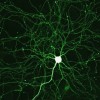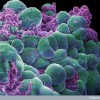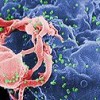
Cockroach Brains as Medicine
Sep 22nd
Each day your body works to defend you against invaders. Harmful bacteria, viruses, and fungi can enter your system and cause diseases. In addition to relying on your immune system, it is helpful to avoid contact with germs by thoroughly washing your hands and keeping your environment clean.
How is it possible that some organisms have the ability to survive in some of the dirtiest places on earth? What survival mechanisms do they have that differ from ours?
Scientists ground up the brains and other nerve tissues from two species of insects, the American cockroach and the desert locust. Material extracted from More >

RBD and Neurodegeneration
Sep 2nd
In an earlier post I blogged about the nature of dreams including phases of sleep and why we dream. In the blog I had mentioned a sleep disorder known as REM sleep behavior disorder (or RBD). It’s a mysterious sleep disturbance where the normal atonia (muscle paralysis) during sleep malfunctions, and the dreamer is left to act out their dreams. Those with this disorder (predominantly male) tend to have dreams that are increasingly violent and involve fighting off an attacker. In their sleep, these people act out every punch, kick, twist and scream with their sleeping bodies, often times injuring More >

Recycled DNA
Aug 25th
The majority of our DNA does not code for protein or RNA and does not seem to regulate how the information is used. Sometimes referred to as “junk” DNA, these regions make up about 98.5 % of our genome. Is this DNA really junk?
Scientists have recently identified a section of “junk” DNA that can regain function and cause disease. The section of DNA is made of repeat regions of the same sequence. They found that individuals who have 1-10 repeats on the end of chromosome 4 can develop one of the most common forms of muscular dystrophy, FSHD. The goal now is More >

Fighting Addiction
Aug 13th
Having an addiction can be devastating, to those that have it and to those that are exposed to it. The addiction can be to a variety of different things such as alcohol, drugs, gambling, internet shopping, video games or even work. But what causes these addictions? Why do some people have the ability to enjoy these things, yet leave them, while others seem to never be able to stop?
Well, it could be your family and it could be your environment. Studies have shown that addictions run in families. In fact, if a parent has an addiction, the child is 4 More >

Fluorescent Controversy
Aug 13th
After conducting a bacterial transformation lab with my students, where we genetically engineer the bacteria to make a jellyfish protein that fluoresces, we always jump into the discussion of why this technique is important. I always try to get the students to think of ways that this could benefit them.
Among other uses, we finally get to the idea that these bacterial cells can be used as factories to make any protein you want, even human proteins. It all depends on what recipe, or gene, you give them. If you give them the recipe to make human insulin, they will. And then More >

Why no cure for cancer?
Aug 5th
I was looking through some of the comments on the blog and thought I would address a few of them, as I imagine others would have similar questions. One reader wanted to know why some cancers are more fatal than others. For example, the five-year survival rate for prostate cancer is nearly 99%, while it is 4% for pancreatic cancer. There are several reasons for this. First, some cancers are by nature slow growing and unlikely to spread through the body, like prostate cancers, while other cancers are very aggressive and often metastasize. Another issue is diagnosis: there are good More >

Could taking a nutritional supplement keep you young?
Jul 14th
It might be more real than not. Scientists working at the biotech giant Geron Corporation have isolated a molecule, TA-65, which has the ability to increase telomerase activity (It is important to note that his find has not been evaluated in published peer reviewed studies as of yet). This is an exciting breakthrough for telomerase is an enzyme that adds DNA sequence repeats to the 3′ end of DNA strands in the telomere regions, which are found at the ends of eukaryotic chromosomes. The telomeres contain condensed DNA material, giving stability to the chromosomes. These telomere DNA sequences shorten with More >

HIV Vaccine?
Jul 14th
We are in the midst of a media explosion surrounding the possibility of a vaccine for HIV. For years this has seemed a hopeless situation, so a great deal of effort and money has been spent on the campaign to educate people about transmission and prevent infection. Unfortunately, according to recent reports (http://www.mg.co.za/article/2010-07-12-hiv-vaccine-the-only-real-answer), the number of new infections is still an alarming 7400 per day! In addition, less than half of the 9.5 million people in low-middle income households infected with HIV have access to anti viral treatments.
These staggering statistics demonstrate very clearly that efforts to help infected individuals are available More >

Designer Babies and Fitter Families
Jul 13th
So-called “designer babies” have generated fervent discussion in recent weeks, sparked by the latest online dating trend: a sperm and egg bank with the goal to make beautiful people. For some, genetic manipulation is a moral necessity, for others it is an ethical outrage. We are reminded of the eugenics movement.
“Better Babies” contests, originally conceived to promote child welfare and physical development, were the first eugenics contests run at a state fairs (the first held in 1908). By 1920, “Fitter Families” contests were also held at state fairs, where human “stock” was judged alongside cows, pigs, and produce. Contestants completed More >

New approach to Alzheimer’s diagnosis
Jul 13th
Alzheimer’s disease is a debilitating, ultimately fatal neurological disorder which affects more than 5 million Americans. The disease has no cure, but the recent decade has seen many promising treatments which all depend upon diagnosing Alzheimer’s as early as possible.
Typically, Alzheimer’s is diagnosed through cognitive testing. Family members or health care professionals may realize that a person is experiencing forgetfulness, disorientation, or other symptoms. Unfortunately, by the time these symptoms are apparent and a diagnosis is made, the patient may have already experience a great deal of brain damage.
A new method to test for Alzheimer’s at a much earlier stage More >
